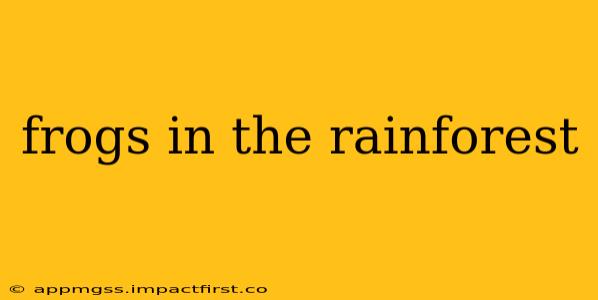Rainforests, the lungs of our planet, teem with life, and amongst the most captivating inhabitants are their frogs. These amphibians, with their vibrant colors, diverse calls, and unique adaptations, play a crucial role in the rainforest ecosystem. This article delves into the fascinating world of rainforest frogs, exploring their incredible biodiversity, ecological importance, and the threats they face.
What Makes Rainforest Frogs Unique?
Rainforest frogs exhibit an astounding level of diversity, showcasing a breathtaking array of colors, sizes, and adaptations. Their vibrant hues, often warning predators of their toxicity, are a hallmark of many species. From the bright green poison dart frogs to the camouflaged leaf litter frogs, their appearances reflect their specific niches within the complex rainforest environment. Many species possess specialized adaptations, such as sticky toe pads for climbing, powerful leg muscles for leaping, and even specialized skin for absorbing water. Their reproductive strategies are equally diverse, with some laying eggs in water, others on land, and some even exhibiting parental care.
What are the Different Types of Frogs Found in Rainforests?
The sheer variety of frog species found in rainforests is staggering. Some notable groups include:
- Poison Dart Frogs (Dendrobatidae): Known for their bright, often toxic, coloration. These frogs secrete potent toxins through their skin, acting as a defense mechanism against predators.
- Tree Frogs (Hylidae): These arboreal frogs are masters of camouflage and often exhibit incredible climbing abilities thanks to their specialized toe pads.
- Glass Frogs (Centrolenidae): These unique frogs have translucent skin, allowing you to see their internal organs.
- Torrent Frogs (Hylidae): Adapted to life in fast-flowing streams and waterfalls, these frogs possess specialized features for clinging to rocks and navigating strong currents.
- Leaf Litter Frogs (various families): Masterful at camouflage, these frogs blend seamlessly with their surroundings, making them incredibly difficult to spot.
What is the Role of Frogs in the Rainforest Ecosystem?
Rainforest frogs are vital components of the rainforest ecosystem, contributing significantly to its health and balance. Their roles include:
- Predators: They control insect populations, preventing outbreaks that could damage plants and other organisms.
- Prey: They serve as a crucial food source for larger animals, including snakes, birds, and mammals.
- Nutrient Cycling: Their waste products contribute to the nutrient cycling within the rainforest, enriching the soil.
- Indicators of Environmental Health: Their sensitivity to environmental changes makes them valuable indicators of ecosystem health, alerting scientists to potential problems.
How Do Rainforest Frogs Reproduce?
Rainforest frog reproduction is as diverse as the frogs themselves. Some common strategies include:
- Egg laying in water: Many species lay their eggs in streams, ponds, or temporary pools.
- Egg laying on land: Other species lay their eggs on leaves, branches, or even on the backs of parents.
- Parental care: Some species exhibit parental care, with parents protecting their eggs or tadpoles.
What are the Threats to Rainforest Frogs?
Rainforest frogs are facing numerous threats, many stemming from human activities:
- Habitat loss and fragmentation: Deforestation and habitat destruction are the most significant threats.
- Climate change: Changes in temperature and rainfall patterns can disrupt frog life cycles and habitats.
- Pollution: Pesticides, herbicides, and other pollutants can poison frogs and damage their ecosystems.
- Chytridiomycosis: This deadly fungal disease is devastating frog populations worldwide.
- Invasive species: Introduced species can compete with native frogs for resources or introduce diseases.
How Can We Help Protect Rainforest Frogs?
Protecting rainforest frogs requires a multifaceted approach:
- Conservation efforts: Supporting organizations dedicated to rainforest conservation and frog protection.
- Sustainable practices: Promoting sustainable forestry and agriculture to minimize habitat destruction.
- Reducing pollution: Reducing our reliance on harmful chemicals and supporting cleaner energy sources.
- Combating climate change: Taking action to mitigate climate change, such as reducing our carbon footprint.
- Raising awareness: Educating others about the importance of rainforest frogs and the threats they face.
By understanding the incredible diversity, ecological importance, and the threats facing rainforest frogs, we can work towards protecting these fascinating creatures and the vital role they play in maintaining the health of our planet's rainforests. Their future is intrinsically linked to our own, and their survival is crucial for the continued biodiversity of our planet.
